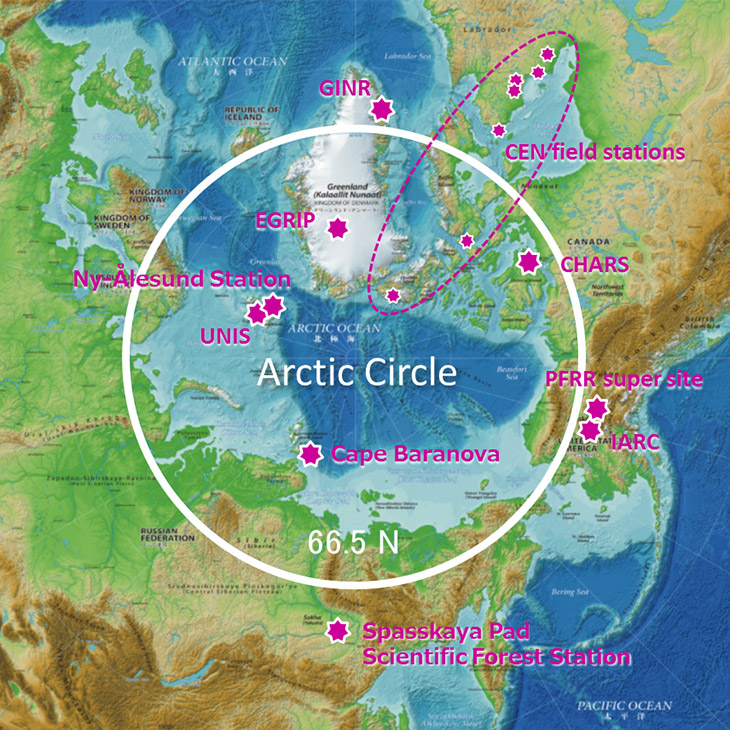Establishing research and observation stations

PI : Dr. Hiroyuki Enomoto (NIPR)
Background
According to Japan's Arctic Policy, there is a demand to strategically establish research and observation stations in the Arctic states as one of the research and development issues that Japan should deal with. This is to promote closer international cooperation through on-site observations and joint research projects, and to promote the effective capacity building by dispatching young researchers to the stations.
Definition
The international collaboration site in the ArCS project is defined as a research and/or observation facility strategically deployed in the Arctic states to achieve the goal of ArCS (*See Purpose of the project) as an infrastructure for international collaborative studies and capacity building.
Overview of the Activity
We strategically maintain following research and/or observation facility in order to support on-site observations carried out by the international collaborative studies.
 The United States
The United States


International Arctic Research Center/University of Alaska (IARC) / 64°51'N 147°51W
Poker Flat Research Range (PFRR) Flux super site / 65°07'N 147°29W
Secure an office space in IARC, serving as a research and observation hub for Japanese researchers and students in Alaska. Partial support for the maintenance of the monitoring site including Flux monitoring tower in PFRR shall also be provided for the study of terrestrial environment changes.
 Canada
Canada


Canadian High Arctic Research Station (CHARS) / 69°07' 105°02'W
The Centre d'études nordiques (CEN) field stations / 53°N - 83°N
Secure a research base for Japanese researchers and students in CHARS, which is available for scientific operations from 2017 in Cambridge Bay. Field training will be carried out with the support of experienced local indigenous people with traditional and local knowledge. The Centre d'études nordiques (CEN) is a research center involving three academic institutions, the Université Laval, the Université du Québec à Rimouski and the Centre Eau, Terre et Environnement of the Institut national de la recherche scientifique. CEN maintains 8 research stations from 53°N to 83°N. Stations are for the researchers of biology, microbiology, geography, geology, engineering, archeology and landscape management.
 Russia
Russia


Spasskaya Pad Scientific Forest Station / 62°14'N, 129°37'E
Ice Base Cape Baranov research station / 79°18'N 101°48'E
Secure an observation site including a flax tower at the Spasskaya Pad Scientific Forest Station in cooperation with Institute for Biological Problems of Cryolithozone (IBPC), Siberian Branch of RAS.
Join in the project at Ice Base Cape Baranov seafront research station, which has resumed operations since 2013, to study atmosphere-sea ice interactions in collaboration with the Arctic and Antarctic Research Institute (AARI).
 Norway
Norway


Ny-Ålesund Research Station / 78°55'N 11°56'E
University Center in Svalbard (UNIS) / 78°13'N 15°39'E
Ny-Ålesund Research Station, located in the international research village (79° N) and managed by the Norwegian government, has been operated by NIPR since 1991, acting as a frontier base for Arctic researchers in Japan. Other Arctic Council observer countries like Germany, Italy, China and Korea are strengthening their research activities in Ny-Ålesund, so we should renovate the station’s facilities to improve its scientific capabilities. UNIS is the world's northernmost university, and provide higher education on Arctic studies. Its well-equipped observation facilities and education and training programs are also useful to promote the ArCS project in the high Arctic of the European sector.
 Denmark / Greenland
Denmark / Greenland


East Greenland Ice Core Project (EGRIP) / 75°37'N 35°59'W
Greenland Institute of Natural Resources (GINR) / 64°11'N 51°41'W
Collaboration with the EGRIP member countries for ice core drilling on the Greenland ice sheet, as well as establishment of research base in GINR, Nuuk, Greenland.
We will secure collaborative bases in the states which face the Arctic Ocean, after the establishment of these research stations. We have been also running two aurora observatories in Iceland for more than 30 years since 1983 in cooperation with the University of Iceland and local residents. In Sweden and Finland, we have maintained close relationships with the Swedish Institute of Space Physics, Sodankylä Geophysical Observatory and the University of Oulu through the collaborative operation of EISCAT radar facilities.
It is highly hoped that this project will enhance the possible use of these observation bases to promote our research and human resources development for Arctic studies. In addition, we will contribute to identifying the scientific, social and political issues that the Arctic states are facing as emergency challenges.

Implementation Structure
| Members | |
|---|---|
| Name | Institutes |
| Hiroyuki Enomoto | National Institute of Polar Research |
| Hiroshi Miyaoka | National Institute of Polar Research |
| Yuji Kodama | National Institute of Polar Research |
| Tetsuo Sueyoshi | National Institute of Polar Research |
| Masaki Uchida | National Institute of Polar Research |
| Kumiko Goto-Azuma | National Institute of Polar Research |
| Hideki Kobayashi | JAMSTEC |
ArCS Blog
- Field observation in Bowdoin Glacier, northwestern Greenland (September 17, 2019)
- Canada-Japan Future Collaboration Workshop at CHARS (July 09, 2019)
- Workshop for Promoting Arctic Collaboration between IARC/UAF and Japan (April 16, 2019)
- Report of the FY2018 program for overseas visits by young researchers: The modified distribution of geese and ecosystem change at Bylot Island and Pond Inlet (October 29, 2018)
- Visit to the Ice Base Cape Baranova research station in Russia (September 13, 2018)
- Workshop with the residents of Qaanaaq in Greenland (August 28, 2018)
- EGRIP deep ice core drilling in 2018 (August 28, 2018)




